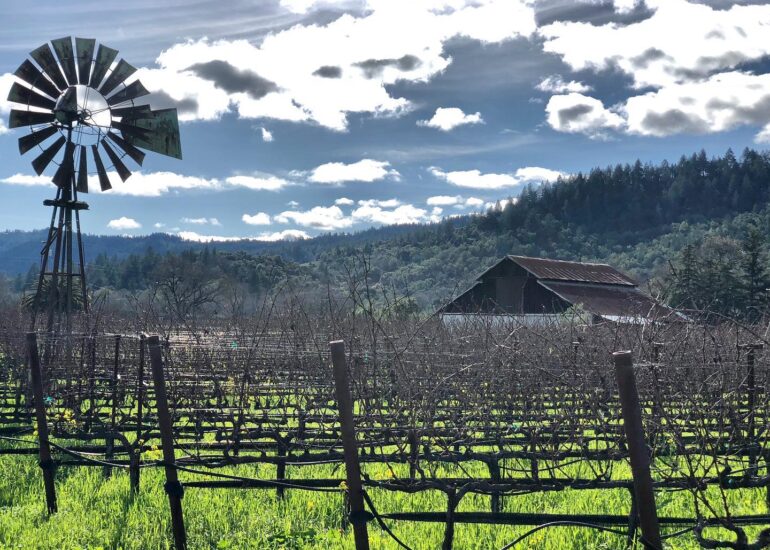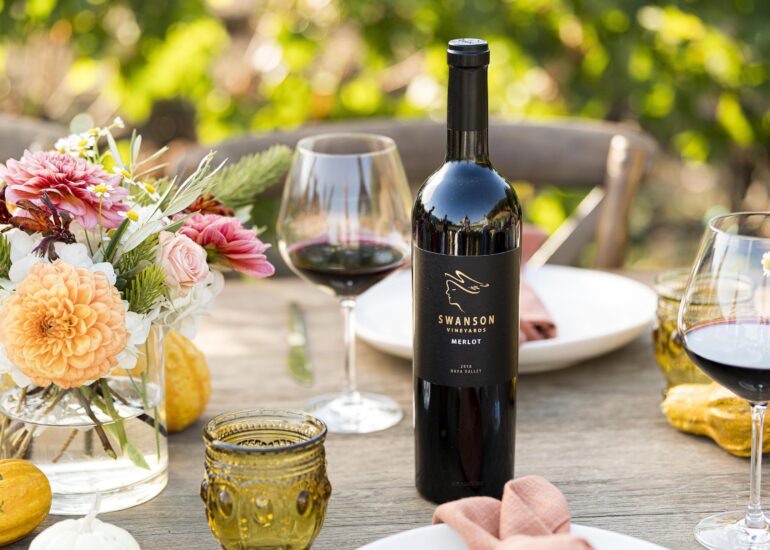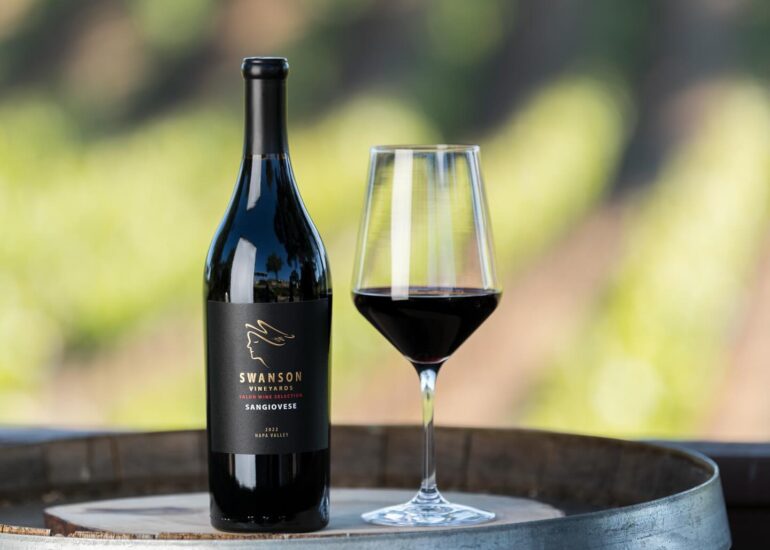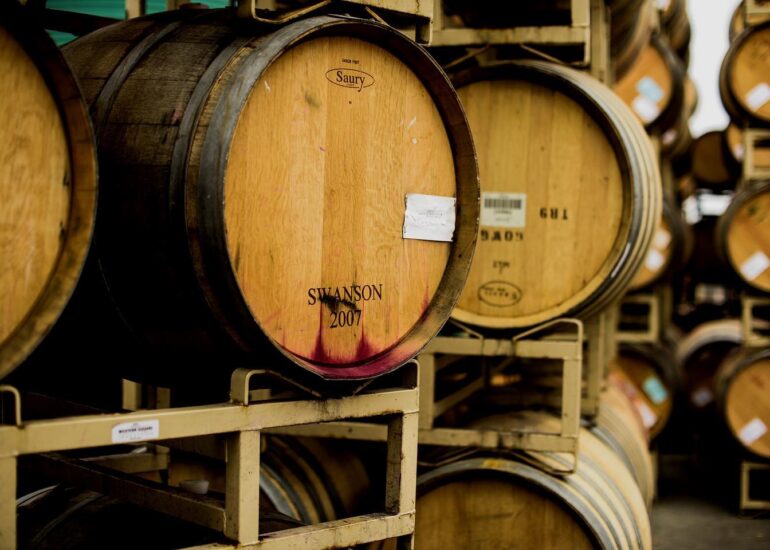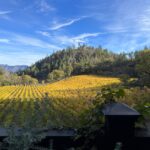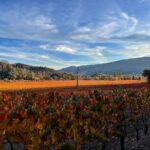The Grace of a Swan
Winemaker Interview
The Grace of a Swan
A conversation with the winemaker of Napa's Swanson Vineyards
Napa Producer Gracefully Weathers the Changing Tides of Merlot’s Popularity
An Interview with the Winemaker of Swanson Vineyards
From its vantage point at the very center of the Napa Valley, Swanson Vineyards has laid witness to considerable change in the region’s wine industry over the last two and a half decades of its own quality-driven wine production. Having first established its reputation during the heydey of California Merlot, a grape variety that has long since fallen out of favor, the brand has recently experienced some challenges in maintaining its market viability on the shifting landscape of New World wines. Now in its sixth year with long-time Napa veteran Chris Phelps at the helm of its cellar operations, the winery is looking to revitalize consumer awareness of a wine portfolio he has since imbued with greater balance and flair. I spent an afternoon with the winemaker, dividing our time between the buzz of his rustic operation in Oakville and the repose of an upscale restaurant in Yountville. He spoke candidly of how the last twenty-five years have seen considerable evolution in his own winemaking, significant changes to the business in Napa, and ultimately, unwavering grace in how the Swanson wine brand has handled the pendulum swing of Merlot’s popularity in the marketplace.
The name Swanson has always been associated with entrepreneurial pursuits, beginning with owner Clark Swanson’s father and uncle who founded the original Swanson company of packaged foods. Clark himself had been ambitiously involved in other industries until the winery became his real focus, culminating in 1985 with his purchase of the main vineyard in Oakville. That point marked the beginning of Swanson Vineyards’ commitment to the quality winegrowing it continues to this day.
— Nikitas Magel
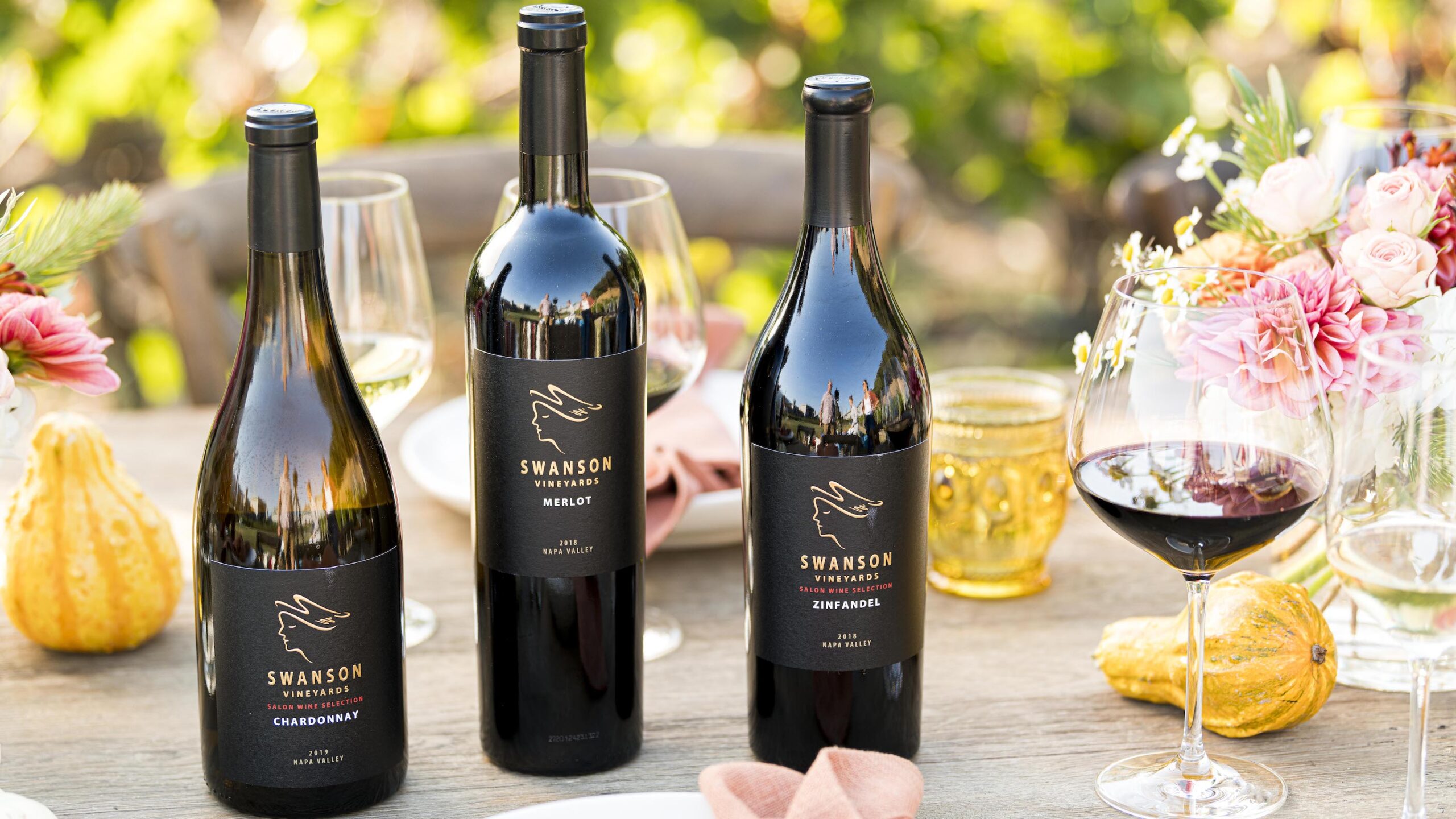
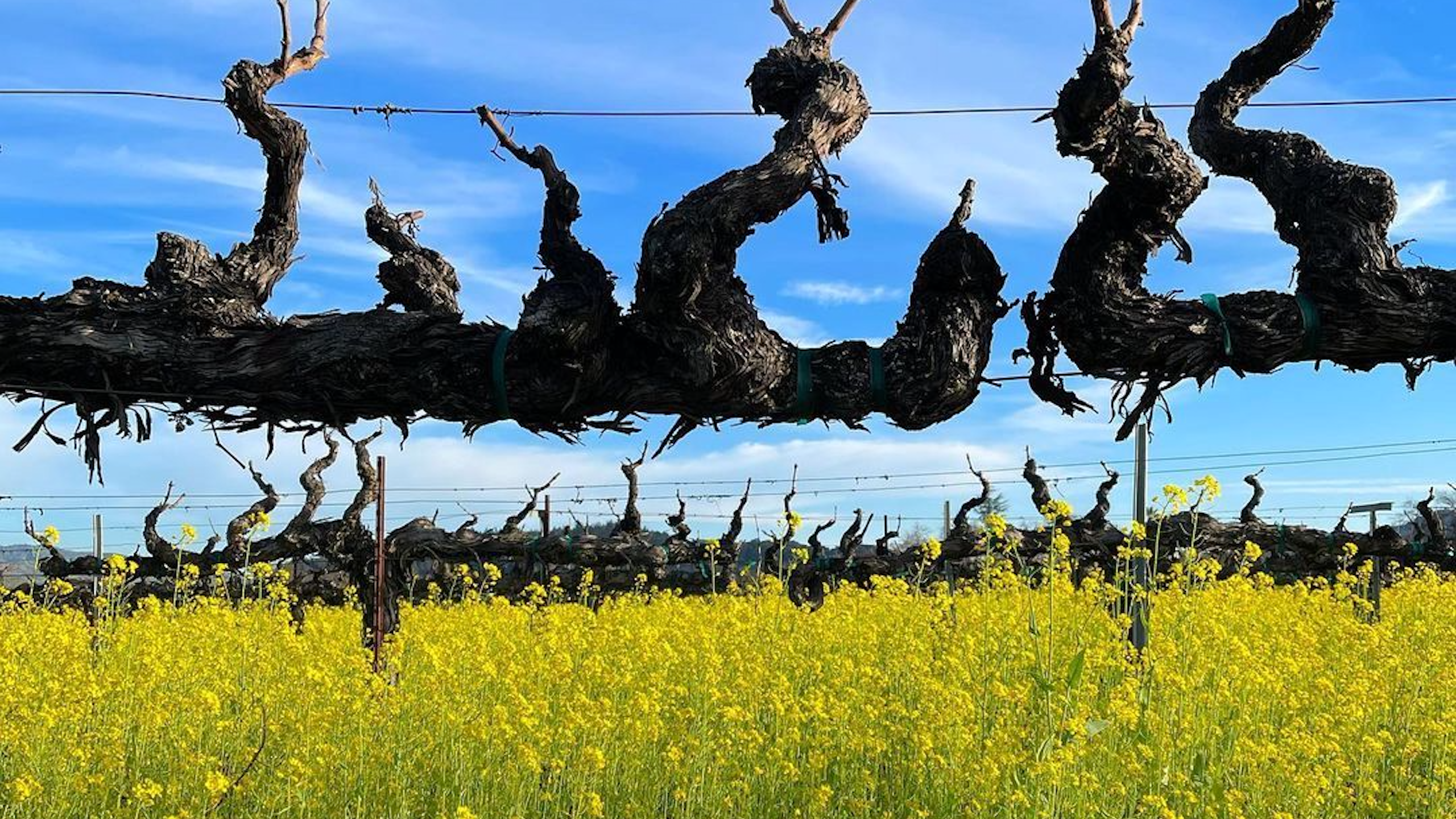
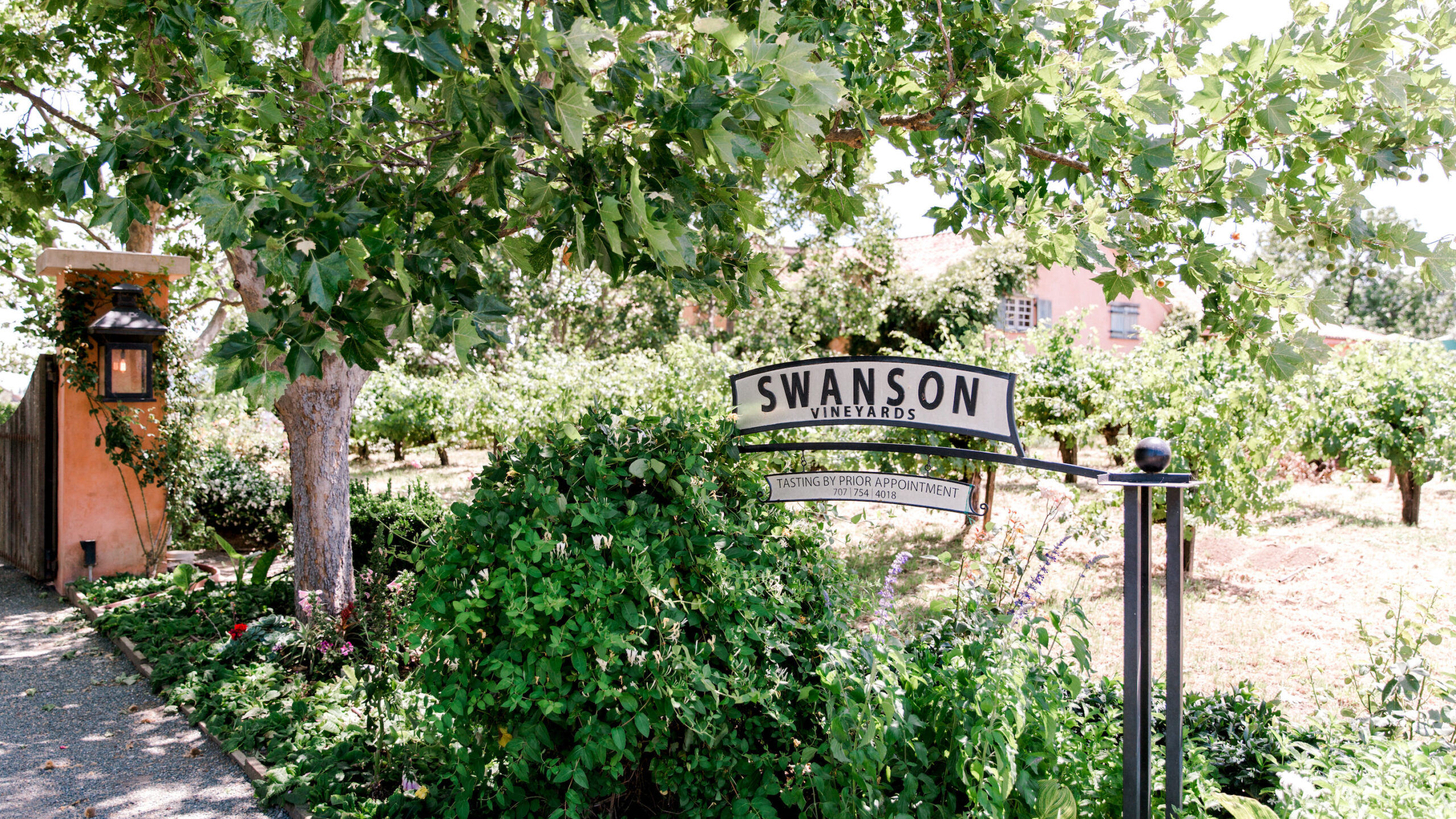
Bettering the Brand
Nikitas Magel: How would you describe what Swanson Vineyards represents as a wine brand?
Chris Phelps: I think it all comes from a place where quality is the driving force. That’s the real common ground I have with Clark Swanson; he understands that. And that drive has been the case for me, first at Dominus, then at Caymus, and now here at Swanson. It’s important on a number of levels because there are a lot of decisions along the way, from before you even plant the grapes to when you bottle the wine, where you can impact quality.
NM: What compelled you to come to Swanson and how had you changed the status quo?
CP: I came to Swanson in 2003. In a way, I was coming full circle because I’d been immersed in Cabernet Sauvignon for twelve years at Dominus and another seven at Caymus, whereas Swanson’s focus has been Merlot, which has recently become a much maligned word — ironically, being the most ubiquitous red grape in the world and one that’s often associated with quality. Now, for a winemaker there are basically three kinds of opportunities — you can go to a startup winery, one that’s just out of the blocks and a brand new business where everything needs of be invented; you can go to a winery whose wheels are pretty well-oiled, to keep things running and make improvements where possible; and then there’s the winery that has problems, where you go in to fix problems.

CP: But Swanson was a different case altogether because the wines were good and a lot of sound decisions had been made, though there was definitely room for improvement. Part of that involved building the brand, since it has been more or less under the radar. See, the Swansons are fairly humble folks and don’t like to blow their own horn, and they wanted the brand to be one that’s sought out rather than out in the open, waving its banners. So the question became, How can we build the brand and make it stronger in the marketplace, while at the same time improving the wines? We needed to take what was good raw material and build that into something more.
At the time I came, the general manager was Stu Harrison, who got Opus One off the ground and really understands brand-building. We were able to work with the ownership to maintain a focused three-pronged approach — Pinot Grigio, Merlot, and Alexis (which at the time was a proprietary blend but is now a Cabernet) — because with his entrepreneurial spirit, Clark Swanson was always wanting to try new things, including varietals. But you can’t really build quality unless you’re consistent with the product mix! So, while we do make a number of other wines in small volume for direct sales, we’re really sticking with these three core wines. And what we’ve done to improve them over the last six years is really derived from my personal approach to wine, which is that you should be honest with the terroir and the site you’re working with, trying to coax what you really believe that vineyard can and should do. Then, at the same time, it’s important to be honest and direct with the varieties themselves, because in winemaking we can oftentimes do things to obscure those qualities — using lots of oak, leaving residual sugar, mixing in other varieties, etc. Overall, I believe our approach has worked well for the evolution of Swanson, this renaissance of the brand that I think I’ve been a part of over the last six years.
Winemaking Wisdom
NM: So, it sounds like your work at Swanson has underscored the importance of your values as a winemaker. What would you say are some of those values?
CP: Ultimately, it’s about the people, and the prospect of working with these people felt good. It’s about the quality of what’s going on and the potential of harnessing that commitment to quality, and I believe that’s definitely the case here at Swanson. Plus, I think most winemakers worth their salt will admit that they’re never satisfied; we’re always looking for some edge to make things better. We don’t have a very high-tech winery here and I didn’t have one at Caymus either, but you don’t really need a high tech winery. A lot of this is based on intuition. It’s been said that winemaking is both an art and a science, and I certainly believe that. One reason women make good winemakers, I think, is that they’re not hesitant to use intuition, whereas men tend to rely on data and empirical notions. But it’s really important to be able to say from your gut what a wine tastes like. When it comes to major decisions like when to pick [the grapes] and how to blend [the base wines] — but even the more minor decisions — being able to rely on intuition is very important. The winemakers I admire the most tend to shoot from the hip. And so, here at Swanson specifically, I think there’s still a lot of untapped potential; I think the wines have been elevated, but they’re somewhat under-recognized. We just have to find the medium for the message.
NM: And have you learned anything during your tenure so far that has made you re-evaluate prior assumptions about winemaking?
CP: The first word that comes to mind is flexibility. After twenty-five years as a winemaker, you can easily lose your ability to be flexible; you develop a set way of doing things. But I think at Swanson I’ve rediscovered the ability to be flexible. For one thing, vineyard sourcing has shifted in the six years I’ve been here; I’m working with a different set of vineyards today than I was when I got here. And in a way that has kept me sharp! You could look at it as a point of frustration, but if you can be light on your feet and respond in a carefully considered way, you can use that to your advantage.

NM: Tell me more about that shift in vineyard sourcing. What has been both rewarding and challenging about working with growers and sourcing their fruit, both which you feel is universal in your experience and which you feel is unique to Swanson?
CP: When I arrived in 2003, we were at about 85-90% estate fruit. Today, it’s closer to 50%. We sold a Cabernet vineyard recently, so things shifted and it was really up to me to come up with a solution for that. And it turned out to be a great opportunity because instead of relying on that one source for Cabernet, I’ve got eight right now, which is even more exciting. As far as working with the growers themselves, it’s all about relationships. Even in cases where we don’t own the vineyard and are just buyers of a commodity, we are — of course, in different ways and in varying degrees — intimately involved in relationships with our growers. We work very well and quite closely with them. Of course, it’s not the same as if we owned those vineyards ourselves, but it comes pretty close! I think the best grower-producer relationships in the [Napa] Valley are the ones where you do have that high degree of intimacy. For example, we buy Cabernet from the owner of the three acres of vineyard surrounding the winery here, so if we notice that some of the leaves need to pulled or something, we almost hate to make the phone call because they’re going to be hurt that they didn’t catch it first! And because of our close relationships, we’re having a great deal of success coaxing the best possible fruit out of these vineyards. It takes a little more work — all good relationships take work — because there’s an inherent inconvenience in having to deal with other people, but that’s also part of the richness to the whole enterprise.
Evolution of an Industry
NM: You’ve been making wine for two and half decades, and it’s all been right here in the Napa Valley. Given that, you’ve witnessed changes in many facets of the industry here: the physical landscape, the market demands, and trends in viticulture and winemaking. What would you say is the most significant change you’ve seen?
CP: I’ll answer that in terms of the Bordeaux varieties because I think that’s the heart of the matter here, mostly Cabernet and Merlot. The biggest change has been stylistic. In 1999, there was a big shift; it was the first year where, almost across the board, we went to a whole new degree of ripeness, to higher levels of alcohol, and to a more over-the-top style in the wines. I’ve talked to others who have also been making wine for over twenty years and found that many of us, in tasting fruit to become wine, are looking for the same parameters: flavor balance and the disappearance of greenness, in terms of the pyrazines responsible for vegetal flavors and also in terms of the tannins. While we can’t go back in time, I really believe that I was looking for the same things twenty-five years ago.
I think that change in style has something to do with the climate; I don’t think you can explain it entirely with clones and rootstocks, though they’re part of it. But a lot of the difference, I think, results from climate change. Whether it’s global warming or not, manmade or not, is purely incidental. Regardless, I know something has shifted and I can’t think of anything else to account for it. And I believe this shift began in ’99, which was a huge year both in terms of quantity and quality, and one where a lot of great Cabernets were made. It got pretty darn hot that September, and that roasted a lot of fruit in the vineyards. So, people who hadn’t intended on making really ripe fruit bombs did — and then the style was well-received by critics and consumers! Now, I’m not sure that a lot of these wines are aging very well and I harbor some great concern about that, but then you could come back and ask, ‘But who really buys wine to age anymore?’ Because a lot of people want to drink their wines really young.

NM: Across the board, among quality-driven wine producers and especially others in the media, I’ve heard concerns about this ripeness-creep, which many will agree is the most significant change the industry in California has seen in the last two decades. Now, I imagine this issue might be especially alarming for you, given your grounding in Old World wine production. To what extent do you feel that your early Bordelais training shaped your values as a winemaker and your attitudes of how a finished wine should be?
CP: Oh, I think it’s undeniably significant! Jean-Claude Berrouet was a huge part of my learning as a winemaker. But despite concerns about ripeness, I think there’s somewhat of a trend back to wines that have more balance and nuance, where it’s no longer about ‘more is better.’ My favorite wines are not those big fruit bombs and that comes largely from my early training. But I’m not alone, nor am I extreme; there are other winemakers who are more so, who pick before the tannins are fully ripe and whose wines are sharp, short, and austere.
And so, as far as the riper style is concerned, I’ve personally not gone much with that trend. I’m picking at higher potential alcohols only because I feel I have to; otherwise I’ll have green flavors. At 14.6% potential alcohol, chances are that I’ll still have unripe flavors, so I’m going to wait and edge closer to 15% — but without letting it get away; you’re always walking a tightrope. As soon as those green impressions are gone and the tannins taste ripe, I’m going to pick; I’m not going to go take a week’s vacation and give that fruit hang time. It feels wrong to me to let the fruit hang just because you can — that gets more into the raisiny/pruney end of the ripeness spectrum, which to me obscures the fruit. I believe in varietal honesty; I don’t want the Merlot to taste like Cabernet!
Pushing, Pressing, Perfecting
NM: How do you judge the ‘sweet spot,’ pardon the pun, in the ripeness of a particular variety? I understand that it’s not as simple as arbitrarily deciding the level of ripeness you want in your wine and then using that to base picking decisions — we see countless examples of that mindset resulting in imbalanced, frankly pretentious wines. Further complicating the picture is that the exact same variety in another vineyard can have an altogether different trajectory of ripening.
CP: That gets back to intuition. Because there are increasingly more sophisticated analyses that you can have done by commercial laboratories in order to make decisions on picking. But it really comes down to intuition and it’s a decision often best made by the seat of your pants. And this might sound very industrial, but the moment you pick, you’re getting a chemical soup that’s the birthing of the entire wine. So, you’re correct to put a lot of weight on that decision. But as long as I’ve been doing this, I’ve had virtually no conversations about style, per se — I know that sounds funny and isn’t what you were expecting to hear. I’ve been mentored and have since trained myself to visualize what the outcome is going to be at a certain point in the ripening process. Though it’s actually a bit presumptuous for any winemaker to think he knows exactly what’s going to happen. But when you’re working with sources of grapes year after year, you do develop an ability to visualize how a wine is likely to be, based on when you pick.

NM: Apropos, let’s talk about the wines themselves, starting with the Swanson Pinot Grigio. What was it about working with this grape — a new one for you, coming from red Bordeaux varieties — that really expanded your winemaking knowledge?
CP: When I arrived at Swanson, the 2002 vintage of Pinot Grigio has already been made, and I thought it was good. But there were two things I wanted to change. First, the alcohol level had been over 14% and I felt it needed to be under that. Secondly, it was barrel fermented in neutral oak. But to me, aromatic whites in general — Sauvignon Blanc, Riesling, Pinot Blanc, and particularly Pinot Gris/Grigio — really shouldn’t be in oak barrels at all; they’re too sensitive to oxidation. Whereas the Chardonnay, when we tried to keep it in stainless steel, it turned bitter. So, with the next vintage of the Pinot Grigio, we decided on an earlier picking point, putting the potential alcohol at around 13.5%, and kept it completely out of barrels so it was 100% in stainless steel. Then, to give it body, which before had come from the higher alcohol, we stirred the lees weekly.
Now, truth be told, this was the first white wine I had to contend with… ever! The biggest thing I discovered in making it was through working with the lees. With red wines, once you rack them, you’re getting rid of the lees. But with many white wines, as long as the lees are healthy and smell good, they’re your friends — the homoepathic, holistic answer to all your problems. [And that’s important because] aromatic white wines can be very sensitive to reduction. Plus, as I said, they add texture to the wine. Thankfully, our assistant winemaker, Tony, is very adept with white wines and has been a huge help with them. In fact, he’s one reason we’ve been so successful with the white wines being as good as they are.
Mastering Merlot
NM: Yes, the Pinot Grigio is a beautifully balanced white wine that demonstrates excellent varietal typicity. But the real excitement, I feel, lies with the Merlot — the lynchpin to Swanson’s brand identity. Tell me about the Swanson Merlot, starting with its origins in Oakville. And what is it about Swanson’s style that you feel best exemplifies Merlot from Oakville?
CP: First of all, we know that there are great places for Merlot on Spring Mountain, Howell Mountain, Atlas Peak, and Carneros. Well, I think there’s a band of soils in Oakville — from Oakville Grocery, out towards Plumpjack — that I think is really good for Merlot. In fact, Silver Oak doesn’t grow any Cabernet in front of their winery, and the best Cabernet at Opus is not at Opus, it’s somewhere else. Another good thing about the Oakville source of Merlot has to do with frost. Even though Merlot is an early budding, early flowering variety, we get through frost very easily and have great fruit set — in fact, we have to drop more [fruit] than most people. So, it’s a very forgiving little pocket for Merlot where we are, in terms of microclimate and soil, and those are the most important aspects. And while some of this applies to red Bordeaux varieties overall in California, for Merlot specifically from Napa, it’s very important to have a very long, cool growing season. And in Oakville we definitely have that.

NM: The Swanson Merlot has very focused aromas and flavors: the telltale black plum, along with a great deal of licorice, black tea, and dark, sweet root. I think it reveals many of the variety’s hidden secrets, if you will, that very infrequently show themselves in most other Merlot — even among those of quality comparable to yours. It’s a clear example of what happens when Merlot is grown in an optimal location and with prime conditions. In light of all that, what decisions are you making both in the vineyard and in the cellar to coax these qualities out in the finished wine?
CP: It sounds simplistic, but it’s straightforward for me to decide when to pick the fruit at the point when it no longer has any greenness in either its flavor components or tannin structure. True physiological, as opposed to physical, ripeness is pretty easy to ascertain. And if you pick that moment right, then everything else seems to fall into place — how to conduct the macerations and fermentations, when to bottle, etcetera. These things don’t seem very difficult if you’ve picked at the right time; if you haven’t, it’s going to be a struggle the whole way through. Some of this sounds like mumbo-jumbo, but you develop a degree of familiarity with all this. Then another one of the ways of maintaining wine quality consistently is by culling out wines and selling them in bulk. I’ve had the onus and privilege, especially after Dominus, of being the one to make that call. For the twenty five years I’ve been making wine for the owners of these three wineries, I’ve had the ability to cull up to 20% of the wine from a particular vintage. And you take a huge financial hit when you do that; you don’t need to know much about the wine business to figure that out.
And the Merlot has really evolved to the point where it is now — a lot. It was very obvious, just from tasting previous vintages of Merlot at Swanson, that the components were already in place and we had the raw material. But there was some critical fine-tuning that needed to be done: early on, it was being harvested, I would say, a week too early; it was being aged in barrels with a heavy toast that should have been medium or medium-plus; and even before all that, there was some selective canopy management that needed to be done. Nevertheless, the elements were there for success all along.
NM: Now, let’s put Swanson’s Merlot in the context of the pendulum swing that the varietal has gone through in the marketplace. California Merlot, as you’re well aware, experienced widespread — eventually indiscriminate — plantings to keep up with demand arising from its skyrocketing popularity in the early ’90s, ultimately resulting in its market demise here in the U.S. Now, more than a decade later, we might be seeing that pendulum begin to swing back towards the center. What is your own assessment of all that?
CP: As is often pointed out in the movie Merlove, there were notions of Merlot out there that did it very little justice. I mean, in bars and restaurants it had become synonymous with a glass of red wine; you could order either ‘red wine’ or ‘Merlot,’ and they’d give you the same thing. And that ultimately became bad news for the variety. Then the movie Sideways added to that negative impact. I can’t tell you how disheartening it was for me to walk into retailer after retailer after that movie came out and be told, “I love this wine! But unfortunately I can’t sell it because it says ‘Merlot’ on the label.”
But I think things are definitely shifting again. And so, here I am picking riper Merlot — because before I arrived there’d been a lot of overtly green tea, almost herbal characteristcs in earlier vintages of Swanson Merlot, to the point where I frankly felt it was defective. I also toned down the new oak and took the heavy toast out of the picture, so that it’s now more about balance and celebrates the idea of Merlot specifically, rather than of just a big red wine.

Lessons and Learnings
NM: Clearly, then, market forces and consumer demand have a tremendous impact on your production decisions, even as they may not jibe with your own values as a winemaker. How would you sum up that push-pull in your own experience and how do you ultimately balance it all to achieve quality and maintain the production of commercially relevant wines?
CP: Early on at Caymus, Chuck Wagner asked me to blend the ’97 and ’98 Caymus red wines. I remember the ’97 being very easy to blend; everything just fell together. But the ’98 I struggled with. So, he pulled me aside during that process and said, “You know, you’re not making these wines for yourself; you’ve got to get over that.” And I was like, “The heck I’m not! Of course I am! It’s all about me!” {chuckling} At the time I didn’t see it, but he was right to put me in my place and remind me that as winemakers we have obligations: to synthesize all the input we get from critics, to be out buying other wines to taste, and to talk to more people and have them taste our own wines. So, that was sort of a pivotal moment. Because since he told me that, I’ve become a little more thoughtful about what I’m doing as a winemaker. It’s important to stay in touch with what’s going on. While you need to have points of differentiation in making the wine for a brand, you also need to be responsible about context and think about how your brand fits into the market.
NM: It sounds like your work, when done well, reminds you to be humble! Overall, how has your experience at Swanson added to your professional winemaking repertoire?
CP: It’s been very fulfilling, and I’ll tell you why. It feels to me that even though I was thrown into a completely new situation with a whole bunch of different variables, I’ve been able to accomplish what I was asked to do — what I’ve asked of myself as well — and to elevate everything to another level. With the team I have in place, we’ve changed vineyard sources and a number of other things, but it’s been fulfilling because as a winemaker, you never want to rest on your laurels; you’re always wanting to take it up a notch. And I feel that in six years we’ve really done that; I think the wines are good.
Now I want to somehow elicit an increased response from the marketplace. And there are signs of that happening: I travel around the country, especially during the first six months of the year, doing wine dinners and promotional work, calling on buyers and the like, and I do see signs of recognition for the brand — more so than just six years ago. I’m confident in these wines and would rather the wines speak than me, but I don’t mind helping them along and I feel that’s my task now, to help the wines find their voice. Bucking the trend with Merlot and dealing with the fluctuation in grape sourcing and other factors, to have still achieved all this is fulfilling. The next challenge is to build awareness of the Swanson brand, and I feel very much a part of that. Because with the discretion of the Swansons, as the winemaker I’ve become, by proxy, the voice of the brand.

NM: In retrospect, throughout all your work in wine, what have you learned that you’ve been to apply in general to your life as a human being?
CP: Over my twenty-five years as a professional winemaker, I’ve had the real gift of being mentored by people who actually continue to mentor me today: Christian Mouiex and his winemaker at [Château] Pétrus, Jean Claude Berrouet (who just retired), from back in my Dominus days; Chuck Wagner from Caymus; and Clark Swanson, here. They’ve all provided a lot of mentoring — I could have a long conversation, and you could even write a book, about each of them! Thinking about just one of them, Jean Claude, a really fascinating person, one thing I learned is that tasting a wine is just like meeting a person. As winemakers, we’re trained to be hypercritical of a wine when we first taste it; we immediately form a first impression. But just as with meeting a person for the first time, why not give that wine a chance?
Sure, we can’t deny that we have first impressions, but Jean Claude appeared to me always to go out of his way to understand a wine before he made some sort of judgment about it. He would look for the positive aspects of a wine — almost to a fault; sometimes it would be frustrating. And his approach to people was identical! Once a wine or a person is in front of you, you cannot change what’s in the glass or who that person is. But you can decide on your perspective. You can control your degree of openness or receptivity. I find that when I let go and allow that to be my approach to a wine, then I experience it very differently.
It was with these inspiring and enlightening words that I was left to savor the sumptuous wines of Swanson Vineyards. They reminded me once again that wine is both the medium and the message for so much that can’t be experienced in life any other way. To learn more about this producer, its story, and portfolio, visit Swanson Vineyards online.
Interview by Nikitas Magel
Photos by Swanson Vineyards

Comments are closed.

